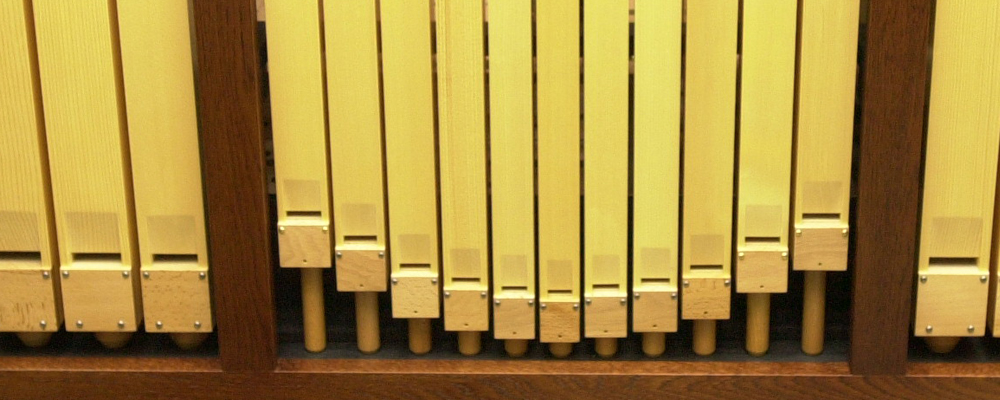The origins of the Pipe organ
The birth of the pipe organ
Early models of ancient Greece
To find the origins of the pipe organ, we must travel back through time to ancient Greece. The earliest pipe organs are thought to have been water organs, or hydrauli, developed at that time in northern Africa.
According to one theory, the water organ mechanism was not originally developed with the intention of creating a musical instrument, but instead was invented as a device to emit a flow of air at a constant pressure. It is said that during a demonstration of the device, with the air fed through an attached pipe to show that the pressure of the air flow was constant, it produced a sound like that of a musical instrument.
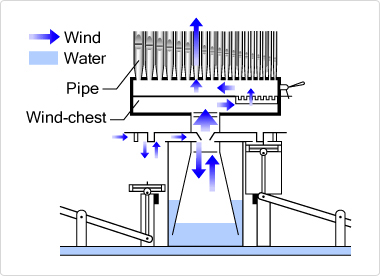
Water organ (artist's impression
How a water organ produces sound
The mechanism by which a water organ produces sound can be understood more easily if thought of as similar to an overturned washbasin submerged in a bath tub. Because there is air trapped within the washbasin, a force known as buoyancy is exerted upward toward the surface of the water. If a hole is made in the underside of the washbasin, the pressure of the water will force the air to bubble out. If a pipe shaped like the body of a recorder is attached, so that the air passes through it, a sound will be produced.
Because the pressure between the air and the water is constant, the air is released steadily. The sound is also sustained at a steady pitch and volume, again because the pressure is constant. Such a scenario is very much like playing a long note on a wind instrument.
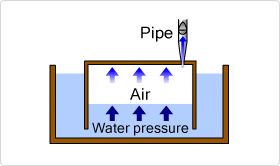
Water organ mechanism (schematic diagram)
In contrast, where the pressure is unstable or oscillates, the sound is similarly transformed or interrupted.
The sound will continue to be produced, not until all the air inside the washbasin has been released but until the surface of the water in the washbasin reaches the same level as the surface of the water in the bath. For this reason, so long as air is intermittently added so that the flow through the pipe doesn't stop, the sound will continue to be sustained.
If the added air were routed directly into the pipe, its flow would be uneven and the sound would not be constant. But through this mechanism the air flows steadily, and it is possible to produce a constant tone.
In practice, the pressure varies slightly according to the amount of air in the vessel, so its release can actually be uneven. It could be said that this is an inherent imperfection of the water organ.
Pumping wind with organ bellows
Later, devices known as bellows and originating in ancient Egypt came to be used for pumping the air on which pipe organs rely (referred to as "wind").
Organ bellows are shaped like a wedge. Their form is similar to that of bellows for more general use, but with weight blocks placed on the upper surface like the model in the photograph. Having been opened by lifting the upper surface diagonally, organ bellows close under the weight of the blocks to pump the required volume of wind.

Small model organ bellows
The bellows attached to pipe organs vary in size and number according to the scale of the instrument, but there are always two or more. This is because when all the bellows are closed completely the organ produces no sound, so before one closes another is opened and they are arranged so that they operate in turn.
In the past, there were organ blowers in addition to the organist. Their work to lift open the spent bellows, with levers, ropes and other mechanisms, would continue behind the scenes throughout the performance. Large organs can be furnished with 4, 5 or even more bellows at their rear.
The pipe organs made now have electric motors that pump wind into the bellows, and it is common for bellows to be kept in an inflated state. This is to say that somewhere, out of view, there is a large air blower. This must be placed out of sight, as it makes quite a lot of noise during operation. In many cases one air blower is used to pump wind into a number of bellows, so it has to be powerful. For this reason and to avoid undesirable noise, a separate room is dedicated to housing this device, with soundproofed walls and fitted throughout with cushioned, sound-absorbing material.
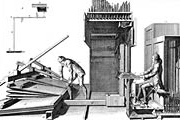
Behind the scenes, the organ blowers' work demands physical strength and fortitude.
Organ bellows are made of wood, and can resemble a large wooden bathtub. It has parts made of sheepskin, which appear white, and weight blocks are placed on top.
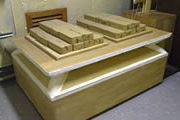
Modern organ bellows are constantly inflated.
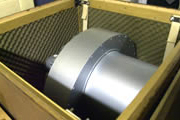
A large, suspended air blower.
Modern, manually operated pipe organs
Even now, new organs are still made with bellows that can be inflated manually. This is because the flow of wind produced with a motor is unavoidably turbulent and eddied, which affects the sound produced as it passes through the pipes. The traditional method produces a better quality of sound because the wind only flows in one direction.
From the Roman Imperial court to the medieval Church
Following the age of ancient water organs, the organ was used to perform musical accompaniments to contests with wild animals at the Imperial court and amphitheaters of Rome. Given the volume of sound the instrument can produce, it seems likely that it was used to stimulate the crowd with rousing sound effects. By this time, it seems likely that organs were already mostly capable of producing a complete scale.
In 757 A.D., Emperor Constantine of the Byzantine Empire presented Pepin the Short, King of the Franks, with an organ as a gift, prompting its spread across Western Europe and Christendom. It is thought that organs have been installed in the chapels of churches since that time, and used to play Gregorian chants, which are comprised of a single melody.
In time, a manual played with the fingers was devised to allow the performance of music featuring harmonies, with two or three notes sounding at the same time. Early keys were 8 centimeters wide and heavy, intended to be played using a clenched fist. The range of the instrument was also more limited than it is today.
Performances at that time were limited to long, sustained sounds played at a slow pace, but it is thought that their formidable sound resounding through the church would evoke a solemn atmosphere.
Over the centuries that followed, both the keyboard and the mechanisms connected to valves that control the flow of wind into the pipes were improved, and the range of available timbres increased, with the instrument having developed almost fully into its current form by the Renaissance. The pipe organ can be considered the original keyboard instrument.
Musical Instrument Guide : Pipe Organ Contents
Origins
How to Play
How the Instrument is Made
Care and Maintenance
Trivia
- Various sizes, from large-scale to pocket-sized
- Can you tell an expensive instrument from its sound?
- Changing fashions in the number of manuals
- Partial bass range
- Delay between play and sound
- Appreciating the aesthetics of churches
- Pipe organ treasures in Tokyo
- Sound that varies according to where it is heard

